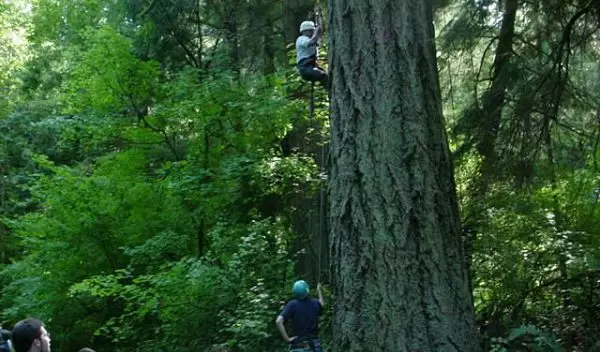
Changes in Altitude/Changes in Attitude: Scientists and Policymakers Share Views in the Treetops
Most of the time, scientists keep to their world and policymakers keep to theirs--and never the twain shall meet. The distance between scientists and policymakers rarely even narrows when they share a mutual interest in science-based policy issues.
The great divide
A case in point: some state governments in the Pacific Northwest have changed the length of the mandatory waiting period between forest harvests without receiving advice directly from scientists whose research concerns the impacts of harvesting practices on forest health.
The distance between scientists and policymakers is neither due to animosity nor a lack of mutual respect. Rather, it is mainly due to the differences--which are almost tribal in nature--between the languages, meeting venues, meeting activities and cultures of scientists and policymakers. Such differences have traditionally reduced opportunities for informal and formal interactions between scientists and policymakers.
The need for bridges
Nalini Nadkarni, a researcher at Evergreen State College, has a special interest in building bridges between scientists and policymakers because she studies the vital, but poorly understood, realm of forest canopies--the uppermost levels of forests, which are critical to forest health. Canopy research, which is conducted from hot-air balloons, treetop walkways, hanging platforms and 30-story construction cranes, shows that about half of the plant and animal species known to science live in forest canopies.
Canopy research also indicates that canopy ecosystems are fragile and vulnerable to human activities such as air pollution, deforestation and climate change. One potentially key way to help protect forests from such threats is to build channels of communication between scientists and policymakers who make decisions about these ecological threats to canopies.
Building bridges
Six years ago, Nadkarni helped build one such channel of communication by creating the "Legislators Aloft" program. During this day-long event, a group of legislative aides from the Washington State legislature, including Democrats and Republicans, spent a day in the treetops with a group of canopy researchers who served as their guides and discussion leaders.
To organize "Legislators Aloft," Nadkarni recruited 12 legislative aides with the help of the Nature Conservancy of Washington State chapter. She selected Millersylvania State Park in Washington, which is only 30 miles from the state capitol, as the site for the day's events. She received funding for the program from the National Science Foundation's Informal Science Education Program and the National Geographic Society.
On the appointed day, Nadkarni and her colleagues kicked off "Legislators Aloft" by training legislative aides how to safely climb trees with harnesses and other mountain-climbing gear to reach skimpy, two-person plywood platforms perched more than 60 feet (six stories) high in the canopy. As the aides' excitement built, it was obvious that they regarded the opportunity to climb tall trees as an adventurous breath of fresh air from their office-bound routines, Nadkarni says.
Pulling back the green curtain
After reaching the treetop platforms, pairs of scientists and legislative aids marveled together at the forest stretching out below and beyond them, and admired the ferns, mosses and lichens that covered nearby branches like floral upholstery. This idyllic setting inspired discussions about the amazing complexity of life, and about how the forest affects people and vice-versa.
For example, Nadkarni explained to the legislative aides that a single canopy branch may harbor more than 40 species of mosses. Though unassuming in appearance, these mosses are masterful multi-taskers, simultaneously performing many ecological services, including providing habitat to insects that consume leaf-feeding insects and habitat to endangered birds, such as a small bird known as the marbled murrelet. In addition, mosses capture and retain nutrients from the rain that are essential to forest health.
After visiting the canopy, Nadkarni says the legislative aides indicated that they would never look at a clump of moss in the same way again, nor would they ever dismiss the endangered marbled murrelet as ecologically insignificant or dispensable.
Program successes
"Legislators Aloft" brought to life for the legislative aides the forest management issues that they frequently address on paper from a distance without ever seeing the plants and animals that are affected by their decisions.
But even more importantly, the program opened doors and generated interactions between participating scientists and legislative aides that demystified their respective worlds for one another. The program did so by removing researchers and policymakers from their offices and routines, placing them on common ground, and enabling them to literally step outside to meet one another. In addition, the day's activities quickly sparked a sense of trust and camaraderie between participants.
"Legislators Aloft" thus fostered the development of personal and professional relationships and ongoing dialogues between participants. Over the last six years, Nadkarni has received inquiries from the program's legislative aides for advice, references or background information on pending legislation that addresses forestry and natural resources issues. She also has occasionally e-mailed or called the program's legislative aides about pending legislation that concerns her. Other scientists and legislators from the program have similarly continued to communicate with one another.
Such exchanges corroborate post-program evaluations, which indicated that 75 percent of the legislative participants were willing to contact a forest ecologist for advice or information about environmental issues in the future.
A model for other programs
"Legislators Aloft" provides a model for outreach programs that may be adapted by scientists in other disciplines. For example, marine scientists could similarly lead decision-makers on ocean outings, hydrologists could lead decision-makers on river kayaking trips, and geologists could lead decision-makers on rock climbing adventures.


